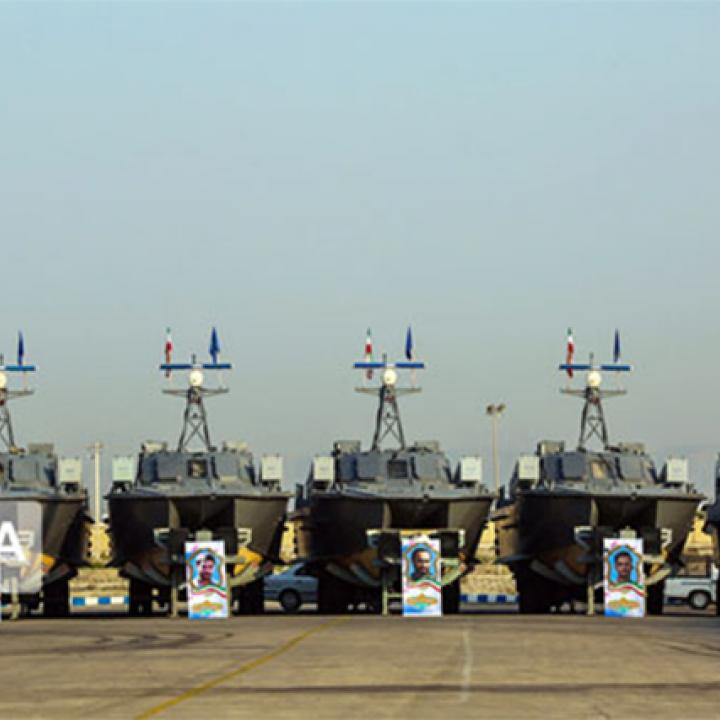

The timing of the exercise and the types of systems and tactics on display reveal much about Iran’s likely response to any uptick in foreign pressure.
On December 20, the Islamic Revolutionary Guard Corps (IRGC) announced the start of a surprise five-day “hybrid” military exercise called Great Prophet 17, with air, land, and naval forces supported by the new “Cyber Electronic Organization” conducting drills on the northern shores of the Persian Gulf. Coming soon after the USS Essex Amphibious Ready Group left the area for the Gulf of Aden, the exercise has seemingly been timed to influence the stalled nuclear negotiations in Vienna and prepare for their potential breakdown. In that sense—and in tactical terms—it resembles the Great Prophet 14 drills of July 2020 (dramatically launched in response to sabotage activities across Iran) and Great Prophet 12 (launched in December 2018 after the Trump administration threatened to bring Iran’s oil exports to a standstill).
Notably, the statement inaugurating the exercise was delivered by the commander of the Khatam al-Anbia Central Headquarters (KACHQ), Maj. Gen. Gholam Ali Rashid, instead of the usual ribbon-cutter, Armed Forces General Staff (AFGS) chairman Maj. Gen. Mohammad Bagheri. This switch could mean Iran is beginning to take the possibility of armed conflict seriously enough to go on a war footing, with the wartime KACHQ taking over operational responsibilities from AFGS.
Whatever the case, Rashid’s stated objectives for Great Prophet 17 were threefold: to increase combat preparedness by testing new weapons and tactics; to simulate one of the IRGC’s “most sophisticated offensive scenarios” in a hybrid warfare setting using interweaving kinetic and nonkinetic methods; and to improve Iran’s “smart deterrence” (i.e., by arguing that Israel will not attack Iran without a green light from the United States, he implied that Tehran will hold Washington accountable for any military action against it). So far, the exercise has reportedly included various coordinated live-fire attacks on maritime and land targets using armed drones, antiship cruise missiles, short-range surface-to-surface ballistic missiles, frogmen armed with magnetic limpet mines, and combined armor and helicopter assaults, all supported by network-integrated air defense.
The drills arrive against a backdrop of worsening rhetoric between Iran and Israel, as well as a growing realization among Western governments that they must do more to influence Tehran’s hardline stance at the negotiating table—primarily by establishing a credible threat of force. In response, Tehran can be expected to leverage all of its tools to deter regional countries from taking part in any possible military scenario and raise the price of any attributable military strike against its nuclear sites. Indeed, Rashid’s statement threatened “immediate devastating attacks against all centers, bases, routes, and airspace used to initiate and carry out airstrikes [against Iran].”
Other notable aspects of Great Prophet 17 include:
- Use of passive electronic measures to locate maritime targets for attacks with missiles or drones from multiple directions.
- Interdiction of maritime corridors with suppressive fire using artillery, long-range rockets, and cruise missiles launched from islands and speedboats.
- The first known use of Fath semi-ballistic missiles, which recently entered service with the IRGC Navy. The Fath is a scaled-down version of the potent Fateh family of short-range ballistic missiles, with an estimated reach of 100-150 kilometers. It can be fired from tubular canisters, up to six of which can be carried on a specially configured truck. For extended range, the IRGC has tested the ability to launch a single Fath from a Sukhoi Su-22 strike aircraft.
- Use of armor-piercing antitank missiles (e.g., the Dehlaviyeh) to attack small maritime targets from close range (up to 3.5 km).
- Use of Almas air-to-ground missiles with Mohajer-6 attack drones, in addition to the battle-tested Qaem miniature bombs extensively used in Syria. These small precision-guided weapons offer a claimed range of 8 km against stationary and moving soft targets.
- More extensive use of attack helicopters against land targets, even though the aviation wing of the IRGC Ground Forces has a very limited fleet of such aircraft (a few refurbished Bell AH-1J Cobras acquired from Army Aviation).
- First known service use of a Karrar main battle tank by the IRGC, seen shrouded in heat-suppressing sleeves.
- Transport of long-range rocket launchers to remote islands using barges, with the goal of denying enemy access to sea corridors.
- Well-known swarm tactics using an even larger number of rocket- and torpedo-armed speedboats.
Given the continuing uncertainty over the nuclear negotiations and the growing threat of military action against Iran, the IRGC and proxy forces can be expected to increase the tempo of their military and paramilitary activities in the region as a means of boosting deterrence. This could raise the temperature in the Persian Gulf, Strait of Hormuz, and Gulf of Oman in the coming weeks, reminiscent of the events of 2019. As Maj. Gen. Hossein Salami put it after Iran struck al-Asad Air Base with missiles in January 2020, the IRGC might choose to “wage a war in order to prevent a much bigger war.”
Farzin Nadimi is an associate fellow with The Washington Institute, specializing in the security and defense affairs of Iran and the Gulf region.



